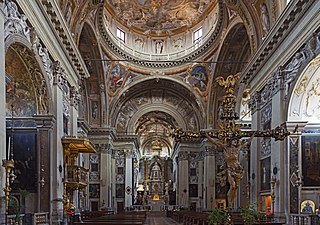Tolentini, Venice
Church building in Venice, Italy From Wikipedia, the free encyclopedia
The Chiesa di San Nicolò da Tolentino, commonly known as the Tolentini, is a church in the sestiere of Santa Croce in Venice, northern Italy. It lies in a Campo of the same name and along the Rio dei Tolentini, near the Giardino Papadopoli.
You can help expand this article with text translated from the corresponding article in Italian. (May 2024) Click [show] for important translation instructions.
|
| Church of San Nicolò da Tolentino | |
|---|---|
 Facade on Campo dei Tolentini. | |
| Religion | |
| Affiliation | Roman Catholic |
| Province | Venice |
| Location | |
| Location | Venice, Italy |
| Geographic coordinates | 45.4374°N 12.3221°E |
| Architecture | |
| Architect(s) | Vincenzo Scamozzi and Andrea Tirali |
| Type | Church |
| Completed | 1714 |

History
The Theatines arrived in Venice in 1527 after the Sack of Rome. The church dedicated to Saint Nicholas of Tolentino was begun in 1590 by Vincenzo Scamozzi.[1] The relationship between Scamozzi and his patrons was stormy, and the church was finally completed only in 1714. It is a large church with a huge freestanding Corinthian portico, the only one in Venice, designed by Andrea Tirali.
The Tolentini is a parish church of the Vicariate of San Polo-Santa Croce-Dorsoduro. The church contains the tomb of Doge Giovanni I Corner, Francesco Corner, Giovanni II Corner, and Paolo Renier. The baroque organ was constructed by Pietro Nacchini in 1754.
Annexed to the church was the monastery, now site of the architecture university of Ca’ Foscari.[1] In 1966 Carlo Scarpa worked on creating an entrance for the institute.[2]
Works of art
- San Nicola da Tolentino
- Ceiling by Mattia Bortoloni
The high altar is by Baldassare Longhena. In 1627, Johann Liss painted a large altarpiece, the Inspiration of Saint Jerome to the left of chancel.[3][4] In 1629 Bernardo Strozzi painted St Lawrence Giving Alms for the chancel.[5]
The funereal monument of the Patriarch of Venice, Giovan Francesco Morosini (d.1678) in the chancel, was completed by the Genovese sculptor Filippo Parodi.[6]
References
Wikiwand in your browser!
Seamless Wikipedia browsing. On steroids.
Every time you click a link to Wikipedia, Wiktionary or Wikiquote in your browser's search results, it will show the modern Wikiwand interface.
Wikiwand extension is a five stars, simple, with minimum permission required to keep your browsing private, safe and transparent.




